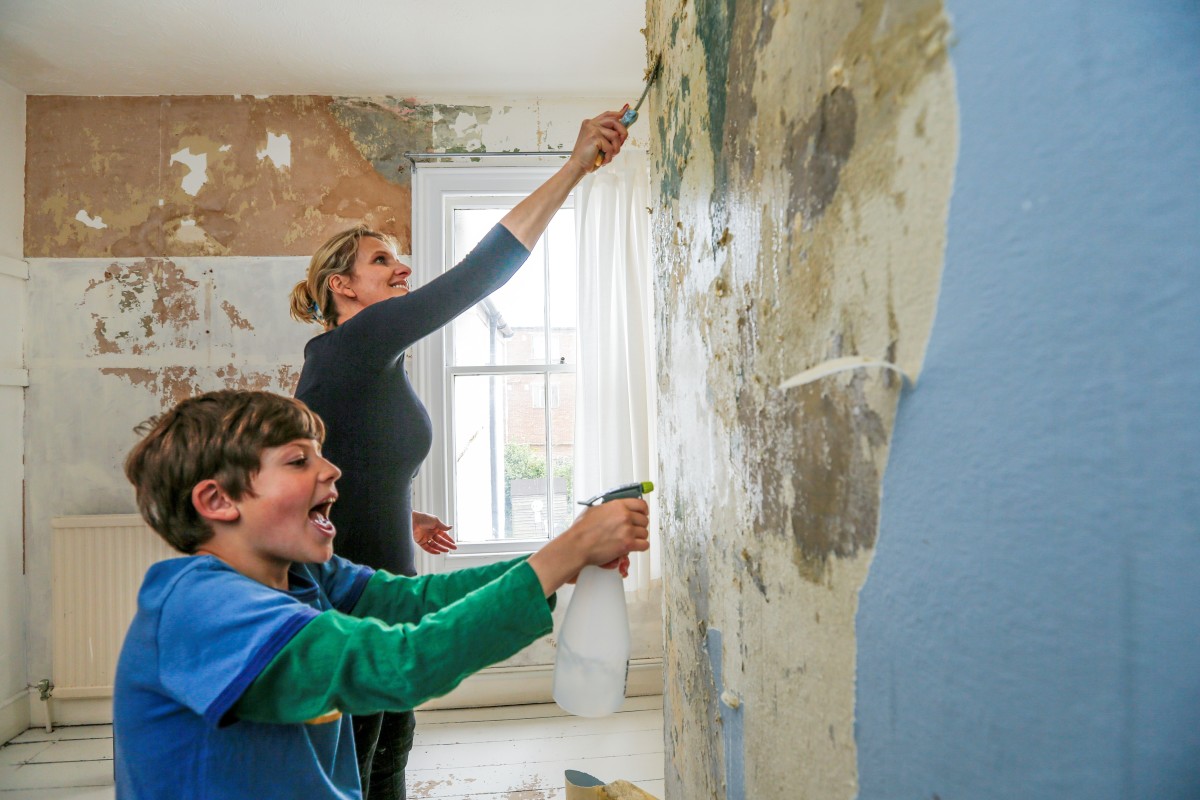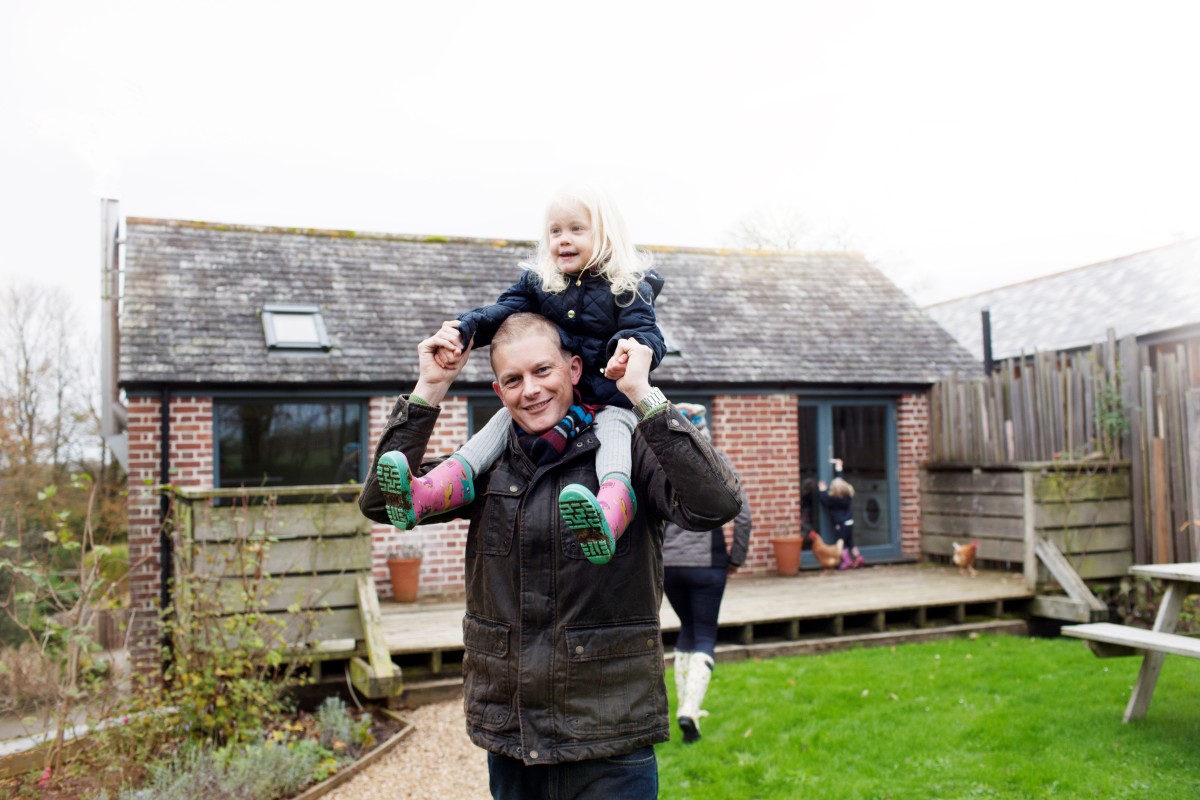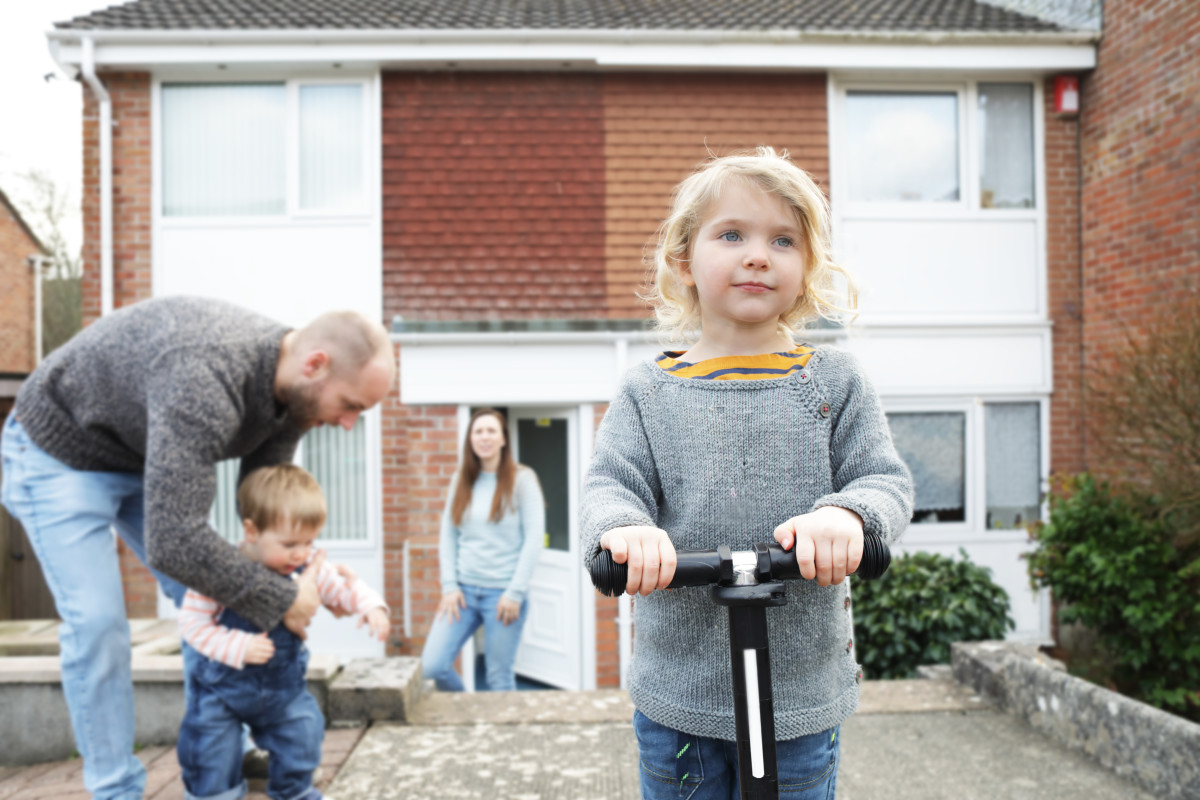Garage conversions on the up: we reveal the most popular home improvements in the UK
If successive lockdowns have had you reassessing your home and lifestyle, you’re not alone. We look at the home improvements that are in hot demand.
Homeowners focused on increasing their space and improving their gardens during 2020 as successive lockdowns forced people to spend more time at home.
With the housing market closed for business in the early part of the year, many people looked to improve their existing space instead of trading up the property ladder.
Successive lockdowns also led to a significant desire among homeowners to have a better property, particularly as working from home looks likely to become the new normal for many.
Meanwhile, as people spent less money on holidays, entertainment and eating out, they had more spare cash to invest in their property, with the Bank of England estimating households collectively set aside £125bn of extra savings between March and November 2020.
The net result was a 25% jump in the number of planning applications for home improvements submitted in 2020, compared with the five-year average.
Which home improvements are on the up?

Planning applications to develop garages soared by 25.3% during the year, while there was a 7.5% rise in people seeking permission for garden buildings and works.
Meanwhile, planning applications for an extension were up 4.3%, according to research by Barbour ABI.
By contrast, planning applications submitted for conservatories dived by 20.9% year-on-year, while the number of people looking to do a loft conversion fell by 2.3%.
The group said the trends showed that people were not only looking for more space during 2020, but they were also keen to make the best use of the space they had.
Another notable trend was a significant increase in homeowners seeking to install solar panels towards the end of the year, which Barbour ABI attributed to people becoming more conscious of environmental issues during the pandemic, as well as an increased desire to be self-sufficient.
Why is this happening?
Successive lockdowns have led to people spending more time at home, with many people working from home for the first time.
As a result, homeowners have become very focused on making better use of the space they have.
Rather than seeing garages as a place for cars, people were instead viewing them as somewhere to store things to free up space in their home, a place to transform into a home office or even as an extension of their property, according to Barbour ABI.
Lockdowns have also prompted people to reconnect with their gardens, particularly due to the good weather during the first national lockdown.
What are the most popular home improvements?
House prices, population density and outside space all greatly influenced the type of home improvements that were undertaken in different regions of the country.
Extensions
Building an extension continued to be the most popular type of home improvement, accounting for 81.7% of all planning applications for homes across the UK.
They were most popular in northern regions, many of which saw double-digit increases in planning applications.
This trend is likely to have been driven by the strong house price growth the northern regions have seen in recent years, making building an extension more attractive financially than moving home.
Garages
Extensions were followed by garages in the popularity stakes, as people looked to build or convert a garage as a way of expanding their home.
The steep increase in planning applications for garages reversed the previous declining trend. It is likely that in many cases, garages were doubling as a home office or workspace.
While applications for garages rose most in Scotland, big increases were also recorded in the East of England and East Midlands.
Loft conversions
Loft conversions were most popular in London and the south east, where they accounted for nearly one in five of all improvement applications.
The group said this is likely to reflect the shortage of garden space homeowners in London may have in which to build an extension, with loft conversions tending to be popular in areas where garden space is at a premium.
At the same time, the higher cost of having a loft conversion done compared with an extension meant house prices needed to be correspondingly higher to justify the work.
Conservatories and garden buildings
Conservatories and garden buildings were most popular in the south west and Wales, possibly reflecting the more rural nature of these regions and the larger gardens of those living there, as well as the popularity of conservatories with retirees.
That said, it should be noted that most conservatory providers offer products with dimensions that do not require planning permission to be installed, so the figures may not reflect the true popularity of conservatories.
The important role played by gardens last year across the whole of Great Britain is reflected by the fact that applications for outside-the-house improvements saw a sizable jump in all regions of the country apart from the north east.
Basements
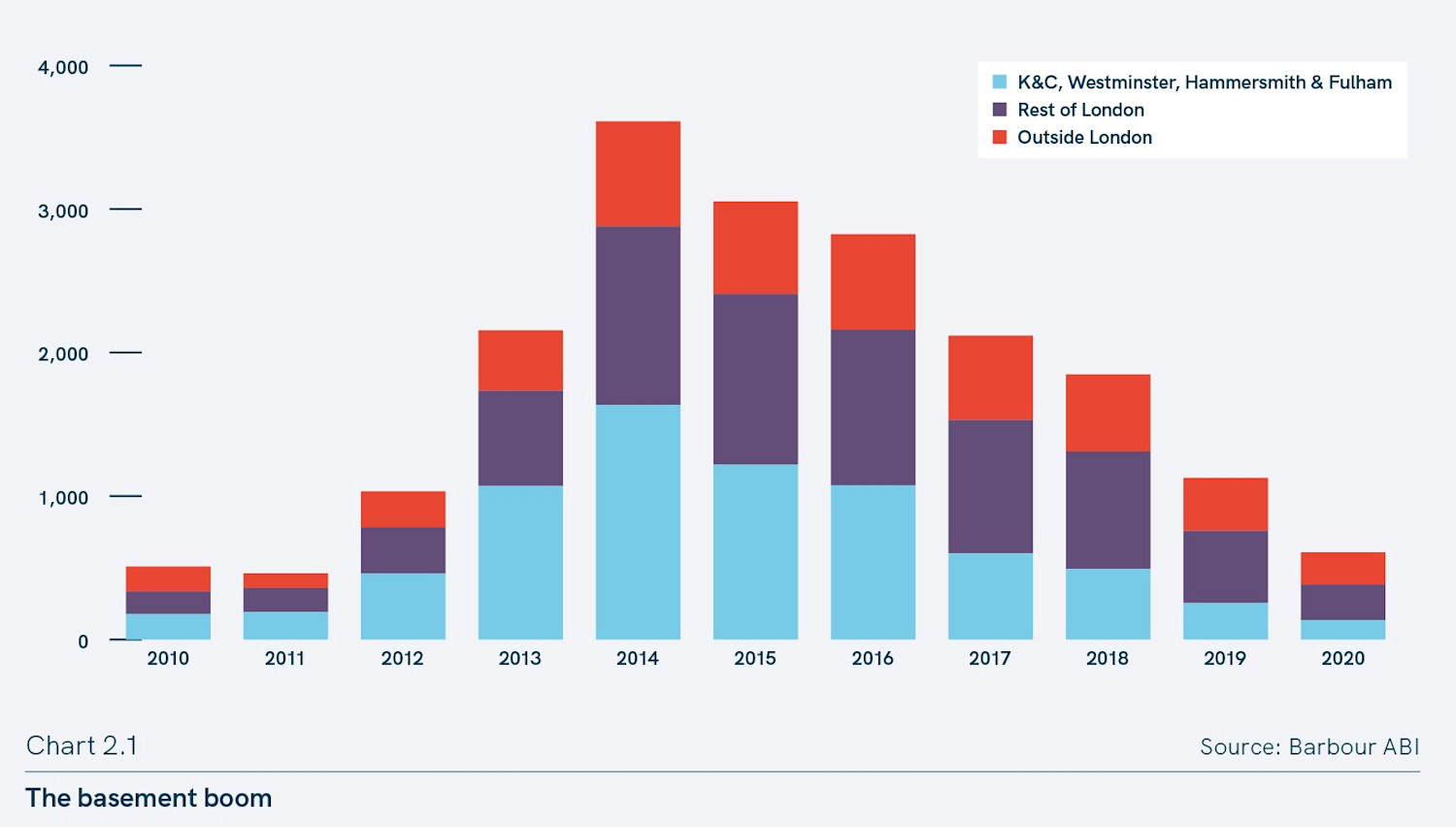
After a steep rise in the popularity of basement developments in London between 2013 and 2016, applications for this improvement have been in steady decline.
ABI Barbour explains that economically, basements only tend to work in locations with high land prices, so that the high cost of having the work done translates into a sufficiently large increase in the value of the property to make it worthwhile.
As money flooded into the London market, basement applications boomed, but once the market started to lose its heat around 2016, demand for basement developments fell back again.
Who are the big spenders?
During the past 15 to 20 years baby boomers have had the biggest impact on home improvements, as this generation not only benefited from high levels of housing wealth, but they also appreciated the value home improvements could add to their property and aspired to live in a home tailored to their own needs.
While those aged between 57 and 75 are still significant home improvement spenders, it is people aged between 30 and 49, an even split of younger generation X and older Millennials, who are now spending the most.
In terms of household type, families with two adults and children are the biggest spenders on home improvements, followed by homes occupied by two retired adults, and those with three or more adults and no children, possibly reflecting the trend for adult children to return to their parent’s home.
Home improvement need-to-knows
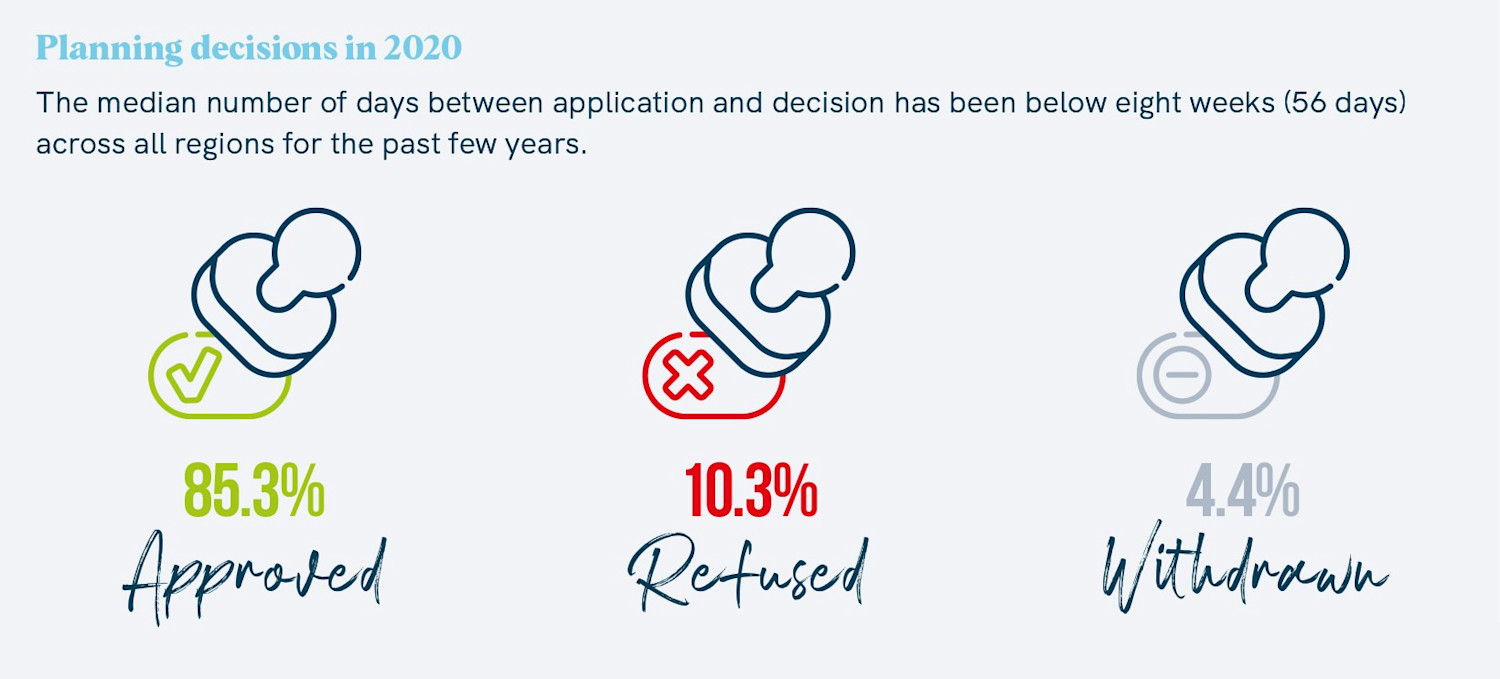
It took an average of 55 days to receive a decision on a planning application across all regions of Great Britain in 2020, slightly up on the 54 days taken in 2018 and 2019.
More than 85% of applications were approved, with just 10% refused, while just over 4% were withdrawn.
London had the lowest level of approvals with 75% of applications given the go-ahead. In the south east and east of England approvals were also slightly below the national average.
But in other regions of the country, around nine out of 10 applications were approved.
London’s lower approval rate is likely to be due to a combination of higher housing density in the capital, meaning neighbours may be more likely to object to applications, as well as higher house prices, which may incentivise applicants to submit more ambitious improvement plans, as the potential gains of adding to their home are proportionately greater.
Top three takeaways
- Homeowners focused on increasing their space and improving their gardens during 2020 as successive lockdowns forced people to spend more time at home
- Building an extension continued to be the most popular type of home improvement
- There was a steep increase in applications for garages and garden buildings. By contrast, planning applications for conservatories and loft conversions fell
Q&A: ‘We think the housing market is on track for its busiest year since the global financial crisis’
Our head of research, looks at what has triggered the recent boom in housing market activity – and what the outlook is as the stamp duty holiday ends.
Q. Despite the global pandemic, the UK housing market is on course for the busiest year since the financial crisis. What’s behind this record-breaking prediction?
The pandemic has actually triggered a lot of the activity in the housing market. Buyer demand has been strong since the end of the first lockdown last year, as households reassess where and how they are living.
The Government has also introduced the 95% mortgage guarantee, which means there’s a wider range of home loans for first-time buyers with a small deposit to choose from.
Many people feel they need more space, particularly families and those for whom working from home is likely to become the norm.
At the same time, many older homeowners are also re-evaluating their housing needs and moving for the first time in many years.
This demand for more space has led buyers to focus on houses and family homes, meaning more expensive properties are changing hands.
Government initiatives are also boosting activity, with the stamp duty holiday encouraging people to bring forward purchases, while the 95% mortgage guarantee has increased mortgage availability for first-time buyers. The government’s recent announcement about First Homes is also likely to have a positive impact on transactions.
We expect activity to remain elevated in the second half of the year, with total sale completions forecast to reach 1.52 million in 2021.
Q. What’s driving up house prices?
Average house prices rose by 4.1% in the year up to April 2021, up from 2.3% in April last year.
Within this total, there was significant regional variation. Wales saw the strongest growth at 6.3%, followed by Yorkshire and the Humber at 5.4% and the North West at 5.3%.
At the other end of the scale, growth was slowest in London, with house prices rising by only 1.9% during the year to April, while Scotland and the South West posted gains of 3.4% and 3.5% respectively.
Prices are being underpinned by strong demand from buyers, which continues to outstrip the supply of homes coming on to the market, driving property values higher.
Growth is strongest in areas where affordability remains good, with the northern regions continuing to see the biggest house price gains.
Q. Where are the hottest and coldest housing markets across the UK - and why?
Wales, Yorkshire and the Humber and the North West are also the hottest regional markets at present, with properties in these regions moving more quickly than in the normal market conditions of 2017 to 2019.
The time between a property being listed and securing a sale subject to contract has fallen by between 10 and 15 days in all three of these regions. As with house price growth, the good affordability of homes in these regions is a key factor driving the markets.
By contrast, inner London is the coldest market, with homes taking just under two months to sell, two weeks longer than the average for 2017 to 2019.
Annual house price growth in inner London is also lagging behind the national average, at just 0.3%, while four central London boroughs have registered price falls for the third or fourth consecutive month.
London is a global real estate market, and inner London has been hit particularly hard by the global shutdown of international business and leisure travel due to the pandemic. Affordability constraints also continue to act as a drag on the wider London market.
Q. The stamp duty holiday on the first £500k of property is set to come to an end later this month. What impact will this have?
Although sales are currently being agreed quickly, there could be delays in getting them over the line due to a conveyancing backlog. This in turn could have a knock-on effect on whether or not buyers meet the stamp duty deadline at the end of June.
Some 53,500 sales were agreed in England for properties priced at above £250k between 8th March and 4th April. In a normal year, for example from 2017 to 2019, it would take on average three months for these transactions to progress from Sold Subject to Contract to completion.
However, given the uptick in activity over the past year, average transactions are now taking four months. This is because conveyancers, local authorities and mortgage lenders are trying to process record levels of sales.
If the 53,500 transactions cited above take four months to complete rather than three months, these buyers will miss out on the maximum stamp duty savings.
But even after this deadline passes, homeowners looking to move up or down the housing ladder will still not pay stamp duty on the first £250k of a purchase up until the end of September, because of the tapering off of the stamp duty holiday.
First-time buyers will also benefit from stamp duty relief on the first £300k of homes costing up to £500k, as they did before the stamp duty holiday was introduced.
Although demand levels are likely to moderate in the second half of the year as the stamp duty holiday is phased out, we still expect activity levels to remain elevated.
Overall, we think the housing market is on track for its busiest year since the global financial crisis.
Q. What’s the outlook for the months ahead as lockdown restrictions continue to ease?
The full reopening of the economy and the unwinding of lockdown restrictions is unlikely to be simple or smooth.
We have already seen the lifting of the remaining restrictions in England postponed from June 21 until July 19, although they will be reviewed in two weeks’ time.
However, we don’t expect this to dampen overall momentum in the housing market this year. The ‘once-in-a-lifetime reassessment’ has got further to run, and the stamp duty holiday extension and 95% mortgage guarantee scheme will also continue to help people move home this year.
Meanwhile, supply constraints will continue to underpin house prices. But even with the lack of supply hampering some sales, we still expect more than 1.5 million homes to change hands this year.
Mortgage lending soars to record high
The choice of mortgages available is on the rise as competition intensifies among lenders. Here’s what it could mean for you.
Mortgage lending has soared to a record high as the housing market is on course for its busiest year since the global financial crisis.
Homeowners collectively borrowed £35.6bn in March, the highest level since Bank of England records began in 1993.
The strong borrowing was driven by people rushing to complete property purchases before the expected end of the stamp duty holiday on 31 March - although the Chancellor later extended the deadline.
Lending looks set to remain buoyant, with 82,700 mortgages approved for home purchases in March, 13% higher than a year earlier.
The number of people remortgaging was more subdued, with just 34,800 mortgages approved for homeowners switching to a different lender, although this figure is likely to reflect seasonal trends, rather than a lack of mortgage availability.
In fact, lenders are very much open for business, with availability increasing across all corners of the mortgage market.
Keen to know what this could mean for you? Here’s what the mortgage landscape looks like for different borrowers.
First-time buyers
The number of mortgages available for first-time buyers has soared recently as banks and building societies flock back to lending to people with small deposits.
There are now nearly 200 different mortgages available for people with just a 5% deposit, up from only a handful at the beginning of the year.
The increase has been boosted by the launch of the 95% mortgage guarantee scheme, where the government ‘guarantees’ mortgages for buyers with 5% deposits.
But there is also a wide choice of mortgages available outside of the scheme, while renewed competition in this part of the mortgage market has led to a drop in average interest rates.
There has been a strong increase in the choice of mortgages available for people with a 10% deposit too, with the number of different deals soaring to nearly 500, compared with only 100 in the same period last year.
Meanwhile, the choice of mortgages for those with a 15% deposit has tripled, as recent strong house price growth has made lenders more confident about offering mortgages to people with small deposits.
But while the number of high loan-to-value mortgages - in other words, loans for people with small deposits - is on the rise, research suggests lenders are still picky about who they lend to.
A study by Aldermore found that only one in five first-time buyers were able to secure a mortgage on their first attempt, with the most common reasons for rejection being a poor credit history, not having a large enough deposit, not being on the electoral roll and being self-employed or having an irregular income.
The findings highlight the importance of taking steps to improve your credit worthiness before making a mortgage application to give yourself the best chance of success.
Existing homeowners
Homeowners moving up or down the property ladder currently have lots of choice, with the total number of mortgages available increasing every month so far this year.
There are now more than 4,000 deals on offer – 50% more than this time last year, bringing us close to pre-pandemic levels.
While existing homeowners typically have larger equity stakes in their home than first-time buyers, the greatest level of choice is no longer reserved for those with a deposit of 40% or more.
Instead, while there are more than 500 mortgages available for borrowers with a 40% deposit, the highest level of choice is for those with a 25% or 20% deposit, with more than 700 deals available in each tier.
And although average interest rates are holding steady, individual lenders are launching eye-catching deals as they look to win new business, with some offering rates of below 1%
However, the increase in competition has led to the average shelf-life of a mortgage – the time for which it is available before lenders withdraw it – falling to just 28 days.
As a result, borrowers will have to move quickly to secure a deal before it gets pulled by the lender.
Buy-to-let investors
Mortgage choice has also soared for buy-to-let investors, with nearly 2,500 different mortgages available to choose from. That's 1,000 more than last year - and more than there were in 2019 too.
A combination of strong house price growth, high tenant demand and rising rents, as seen in our Rental Market Report, has made lenders feel more confident about offering mortgages to investors with only small deposits, with 12 deals recently launched for people with just 15% to put down, ending a period in which the minimum deposit for buy-to-let was 20%.
There is also increased choice for people with a 20% deposit, with nearly 150 loans to choose from, compared with just 19 a year earlier.
Investors who have a 25% deposit have the most choice with nearly 900 mortgages available, more than double the number on offer 12 months ago.
There is more good news for landlords, as interest rates on buy-to-let mortgages have been on a steady downward trajectory since the start of the year, as competition in this sector of the market continues to hot up.
This trend has been seen across both two-year and five-year fixed rate deals and mortgages at all loan to value ratios, pushing average interest rates on two-year fixed rate products below 3%.
First-time buyers offered half-price homes under new scheme
First-time buyers in England could be offered half-price homes through a new government scheme to help people get on the property ladder.
A new government scheme offering local first time buyers and key workers a 30% to 50% discount on the purchase of their first home has launched.
Designed to help those struggling to afford a property in their local area, the First Homes initiative kicked off in the Bolsover district of Derbyshire at the end of last week.
Further sites are set to follow over the next few weeks, with an additional 1,500 homes joining the scheme this autumn.
The government has pledged a further 10,000 properties will be added to the First Homes scheme every year.
Housing secretary Robert Jenrick said: “Thanks to First Homes, we will offer more homes to local people and families, providing a route for first-time buyers to stay in their local areas, rather than being forced out due to rising prices.”
How does the scheme work?
Under the First Homes scheme, a portion of new homes being built will be sold to first-time buyers who meet the eligibility criteria.
They will be sold at a minimum discount of 30% of the open market price, although in some cases that discount could rise to 40% or even 50%.
When the property comes to be sold again, the same discount will be passed on to the next buyer, who must also be purchasing their first property and meet the other eligibility criteria, to ensure the homes will always be available to the local community at below market value.
Prices for the first sale are capped at £250,000, rising to £420,000 in Greater London, after the discount has been applied.
Several national and regional lenders, including big names such as Halifax and Nationwide, have agreed to provide 95% mortgages on properties being purchased under the scheme.
Who is eligible for First Homes?
The scheme is available to first-time buyers in England who are either local or key workers, or in the Armed Forces.
The definition of key workers includes doctors, nurses and teachers, as well as delivery drivers and supermarket staff.
Councils will be able to prioritise homes for key workers who have supported their community through the pandemic, while they can also set their own definition of a key worker to attract people in professions that are considered to be essential to their local area.
Individual local authorities can also set a local connection test for the properties, which may include people who live or work in the area, have family connections to it or need to live there due to special circumstances, such as caring responsibilities.
The scheme is also open to all current members of the Armed Forces, as well as divorced, separated or widowed spouses, and veterans who apply within five years of leaving the forces.
If a property is being purchased by a couple, both individuals must be first-time buyers with a combined annual household income of less than £80,000, rising to £90,000 in Greater London.
At least 50% of the purchase must be funded through a mortgage.
What’s the background?
First Homes is part of the government’s wider pledge to deliver one million new affordable homes by 2024 to help more people get on to the property ladder.
It follows the launch earlier this year of the 95% mortgage guarantee scheme which aims to increase the availability of mortgages for people with just a 5% deposit.
To coincide with the launch of First Homes, the government has also started a new campaign called ‘Own Your Home’ to highlight the support that is available for people getting on to the property ladder.
The campaign consists of a series of broadcast, digital and radio adverts flagging up schemes such as the Help to Buy equity loan, Shared Ownership and Right to Buy.
It is being backed by the Own Your Home website, which acts as a single gateway for aspiring homeowners to get information on the schemes that are available and to help them decide which one is right for their needs.
Top three takeaways
- First-time buyers in England could be offered half-price homes through a new government scheme to help people get on the property ladder
- Under the First Homes initiative, local first-time buyers and key workers will be able to purchase a property at a discount of between 30% and 50% of the market price
- When the property is sold, this discount is passed on to the next buyer
More than half of homeowners live in homes that fail to meet their needs
From pets buried in the garden to the draw of the local coffee shop or pub, our survey lifts the lid on what's stopping people from moving.
Just over half of UK homeowners claim to be stuck in a home that doesn't meet their needs.
The average homeowner says they would need a further £125,000 on top of the current value of their home in order to afford somewhere that's suitable for them.
Our survey of 2,400 homeowners also revealed that people typically stay in their home for more than four years after realising it's no longer right for them.
And when asked what finally prompted them to pluck up the courage to move, 25% of homeowners pointed to an increase in income, while 19% said having children made it vital.
Consumer spokesperson said: “We were blown away to see just how many Brits are living in homes that they don’t feel are right for the needs of themselves and their family.”
Why do homeowners feel their homes no longer meet their needs?
The need for more space was the key reason for why homes were no longer suitable, with 40% of homeowners surveyed citing this as a factor.
Meanwhile 25% said they were stuck in an area in which they did not want to live, and 23% said not having dedicated space in which to work from home was an issue.
The survey comes as many people reassess what they need from a home in light of the pandemic and successive lockdowns.
With working from home for at least part of the week likely to become the norm for many people, the need to have a dedicated space in which to work has increased as a priority, while many people feel they just need more space at home generally.
At the same time, not having to commute into the office every day means areas that are close to work or good transport links no longer hold the same appeal as they once did.
So what is stopping homeowners from moving?
Among those who said they live in a home that was not suitable for them, 39% said being unable to find somewhere that was right for them within their budget was the main factor stopping them from moving.
A quarter of those who did not like their home also said the cost of moving was a barrier preventing them from buying somewhere else.
Emotional ties
While some homeowners are unable to move for financial reasons, others feel tied to their current home for emotional ones.
Around 27% of those surveyed said they had an emotional attachment to their home, while 55% of parents said their children were attached to it.
Among this group, 13% of parents said they could not move from their current home because it would upset their children too much, and 36% said they could not bear to leave the home in which they had brought up their children.
One in five homeowners said they liked their neighbours too much to move, while 8% said they could not leave their property because they had buried pets in their garden.
Lure of the neighbourhood
Meanwhile, for many homeowners, their love of the neighbourhood prevented them from moving. Among these, 26% said their fondness of their local pubs stopped them from relocating, and 21% felt the same way about their local coffee shop.
What could it mean for you?
Our recent research showed that half of homeowners undervalue their property by an average of £46,000.
So if you think you can’t afford to move, it’s worth getting to grips with the current value of your home as you may be in for a nice surprise.
Top 3 takeaways
- Just over half of UK homeowners claim to be stuck in a home that fails to meet their needs
- The average person says they would need an additional £125,000 on top of the current value of their home in order to afford somewhere that is suitable for them
- Homeowners typically stay in their current home for more than four years after realising it is no longer appropriate for them
House prices rise at four times the rate of flats
Hot property alert! The pandemic-led ‘search for space’ and shift to working from home has fuelled buyer demand for houses.
Strong demand from prospective buyers for family homes is causing the price of houses to climb at more than four times the rate of flats.
The average cost of a house rose by 5.2% over the last year, while the value of flats inched ahead by just 1.1% over the same timescale, according to our latest House Price Index.
Buyer appetite for houses, which typically have higher prices than flats, is helping to fuel what is set to be a record-breaking year in the housing market.
More than 1.5 million homes are expected to change hands this year, a staggering 45% more than in 2020. And the total value of homes sold is expected to reach £461bn, up 68% compared with 2019.
Why is this happening?
The ‘search for space’ has been a key feature of the housing market during the pandemic, with successive lockdowns prompting many people to carry out a once-in-a-lifetime reassessment of their homes and lifestyles.
Spending more time at home has led to a desire for more space, both inside and out, particularly for families trying to homeschool and work from home.
And many older homeowners are also reevaluating their housing and lifestyle needs and moving for the first time in many years.
Meanwhile, the stamp duty holiday has provided an added impetus for many people to move more generally. The tax break means buyers pay no tax on the first £500,000 of a property purchase until the end of June, before the threshold drops to £250,000 for a further three months.
This weight of demand has led to houses selling within an average of just 42 days – three weeks quicker than flats.
What’s the background?
Successive lockdowns and the shift in working patterns is having a two-fold impact on the housing market.
On the one hand, it has changed the features people prioritise in their home, as they become more focused on having a larger property with dedicated space in which they can work and get good broadband connections.
At the same time, if workers are freed up from having to travel into the office every day, living close to where they work or in a location with good transport connections becomes less of a priority.
With many companies announcing plans to continue to offer flexible working to employees for at least part of the week, houses are likely to continue to be hot property.
The ‘search for space’ trend still has further to run, according to Head of research. And it’s a sentiment shared by a member of the Bank of England’s Monetary Policy Committee in a speech recently.
"The easing of lockdowns will continue to cause a natural fall in demand as people are able to see family and enjoy amenities that have been shut for more than a year.
"But new buyer demand will still emerge throughout the second half of the year as office-based workplaces confirm if they will be pursuing more flexible working practices," Gilmore explained.
"Households who have the opportunity to commute less frequently have more options when it comes to choosing where to live, and this could prompt a move.
"Likewise, older households will continue to review how and where they are living, with many more set to move for the first time in years.
"With an increased array of mortgages to choose from, first-time buyers will also remain active in the market."
What could this mean for you?
The mismatch between the levels of buyer demand and homes for sale means that if you have a house to sell, particularly a family home, you are likely to be in a great position to agree a sale quickly.
Things could be trickier if you try to coordinate the sale of your current home with the purchase of a new one, due to the shortage of properties currently on the market.
However, more homes are expected to be put up for sale as further lockdown restrictions ease and the vaccine roll-out continues.
Buyers
With demand from potential buyers outstripping the level of homes for sale, if you’re looking to step onto, or up the housing ladder, you’re likely to face competition.
And it’s likely to be tougher if you’re looking to buy a house, particularly a three-bedroom family home, the most coveted property type.
So get organised to give yourself the best chance of securing the home you want.
Pull together any paperwork you will need for the purchase and try to secure a mortgage offer in principle to put you in a good position to move quickly when you do spot something you like.
If you complete on a property – in other words, legally transfer ownership – before 1 October, you could benefit from the stamp duty holiday too.
Top three takeaways
- Strong demand for family homes is causing the price of houses to climb at more than four times the rate of flats
- The average cost of a house rose by 5.2% in the last year, while the value of flats inched ahead by just 1.1%
- Buyer appetite for houses has contributed to the estimated total value of homes that will change hands this year soaring by 68% compared with 2019
Renters return to city centres as lockdown restrictions ease
The revival comes as offices start to reopen and rental affordability improves, particularly in London where it has hit a 10-year high.
A three-speed rental market is emerging across the country as renters start to return to city centres.
One year on since the housing market reopened, the pandemic-led drop-off in demand for rental homes in city centres is starting to bounce back as lockdown restrictions lift.
Major city centres
Demand for rental homes in central Edinburgh soared by 26% in the month after Easter, while it is 12% higher in central Leeds and 5% higher in central Manchester.
There is a seasonal element to this trend, but the rise in demand in these city centres has outpaced the growth in wider commuter zones over the same timescale.
Rental affordability has also improved in most cities, with rents in Manchester now accounting for 28% of a single earner’s income, down from 30% in March 2019.
The exception to this demand trend is Birmingham, where it has slowed since Easter – after a much stronger period through February and March across the wider city.
London
A similar pattern can be seen in central London, where rental demand is up 7% in the month since Easter.
Rental falls in London bottomed out in February, with overall rents in the capital now down 9.4% in the year to March.
Rents in London are now at their most affordable in 10 years. They account for 42% of a single earner’s income, down from 49% last March, and a peak of 53% in the last months of 2016.
Average rents in the City of London, Kensington and Chelsea, and Westminster, have fallen to their lowest levels in a decade, with Westminster rents running at £2,259 per month - down from £2,617 per month in February last year.
What's the background?
The impact of the pandemic was felt most acutely in city centre rental markets, as people searched in less urban areas for homes with more space, both inside and out.
Central Edinburgh, Leeds, Manchester and London were at the forefront of the rental slowdown, as offices were shut and a hiatus in tourism took hold.
It drove a softening of rents in these city centres, which are still down on the year by 0.7% in Leeds, 1.1% in Manchester, 3.2% in Edinburgh and 9.9% in London.
However, the city centre downturn is starting to reverse as the economy opens up, workers start to return to offices, leisure activities restart, and renters return in search of a rental bargain.
Who could it mean for you?
Landlords
With rental demand building particularly in city centres as lockdown eases and offices start to reopen, if you have a rental property in one of these areas, you could be in a good position to let it.
Tenants
Affordability has improved in most cities, and many renters in the capital are looking to lock in the current affordability for as long as possible. Estate agents have reported an increased number of tenancies for longer than 12 months being agreed in London.
What’s the outlook?
Gráinne Gilmore, head of research at Zoopla, said: “Demand will continue to rise in city centres as offices start to reopen and this, coupled with increased affordability levels in many cases, will start to counter the negative pressure on rents seen over the last 12 months.
“In London, where rents are down 9.4% on the year, a modest reversal in rental declines has begun, but it will be a slow build back to pre-pandemic levels in inner London. The recovery will be uneven and we expect new or recently refurbished properties to attract higher levels of demand in the second half of the year.”
Top three takeaways
- Rental demand is bouncing back in city centres as lockdown restrictions are lifted and offices start to reopen
- It's led to a three-speed rental market emerging: major city centres, London, and wider commuter zones and beyond
- In central London, rents in several boroughs have fallen to their lowest level for a decade, tempting tenants back
Housing market on course for busiest year since global financial crisis
The stamp duty holiday and the pandemic-led 'search for space' are set to lead to the highest level of homes changing hands for 14 years.
The housing market is on course for its busiest year since the global financial crisis as the scramble for properties continues.
More than 1.5 million homes are expected to change hands this year, a staggering 45% more than in 2020, according to our latest House Price Index.
With the number of housing sales each year rarely exceeding 1.2 million over the last decade, this would mark the highest level of housing market activity since 2007.
As well as breaking a recent record, 2021 looks set to be one of the top 10 busiest years since 1959.
Meanwhile, the total value of homes sold in 2021 is expected to reach £461bn – up 46% or £145bn compared with 2020, and 68% compared with 2019.
While this is largely being driven by the sheer volume of homes changing hands, it is also due to more expensive properties selling amid the pandemic-led 'search for space'.
What’s happening to house prices?
House price growth has almost doubled during the past year to stand at 4.1% in April, up from 2.3% in the same month of 2020, as demand from potential buyers continues to outstrip the supply of homes on the market.
House price growth is strongest in areas where affordability is greatest. Wales leads the way at a regional level, with house prices up 6.3% year-on-year, followed by Yorkshire and the Humber at 5.4% and the north west at 5.3% respectively.
At a major city level, Liverpool and Manchester have seen the highest levels of house price growth for the fifth month in a row at 6.9% and 6.8% respectively – twice the level recorded in the more normal markets seen between 2017 and 2019.
However, price growth is slower in southern regions where affordability is more stretched.
London recorded the slowest regional rate of house price growth for the sixth month running at 1.9%, well below 3.5% seen in the south west and east of England.
House prices in the heart of London are almost unchanged year-on-year. And a number of boroughs have actually seen price falls, reflecting the softening of buyer appetite in the capital during the peak of the pandemic.
Property values are 2.5% lower than a year ago in the City of London, while in the City of Westminster they are down 2.2%, and in Kensington and Chelsea, and Hammersmith and Fulham they have dropped by 1.7% and 1.4% respectively.
How busy is the housing market?
The level of buyer interest in homes on the market is currently 29% higher than it was in 2020.
It's fuelled in part by the extension of the stamp duty holiday until the end of September as well as the ongoing 'search for space', with many people carrying out a once-in-a-lifetime reassessment of their homes and lifestyles in the wake of multiple lockdowns.
First-time buyers also now have a wider choice of mortgages available to help them onto the housing ladder.
Unfortunately, the high level of buyer demand is not being matched by the volume of homes for sale, with supply 20.8% lower than last year, putting further upward pressure on prices.
Where are the hottest markets?
Wales, Yorkshire and the Humber, and the north west are the hottest regional housing markets. The time it takes between marketing a property and agreeing a sale in these locations is 10 to 15 days faster than it was in 2017 to 2019. These regions also have the strongest house price growth.
The ‘hottest’ city markets, where homes are being sold more quickly and price growth is strongest, include Wigan, Blackburn and Burnley. A typical property in these markets is selling three weeks faster than in 2017 to 2019, and annual price growth is at least 5.8%.
At the other end of the spectrum, homes in the heart of London – where house prices are almost unchanged on an annual basis – are taking nearly two weeks longer to go under offer.
The property market is also slower than a year earlier in Aldershot, Coventry, Edinburgh, Gloucester and Southampton, bucking the wider trend of faster moving markets. However, annual price growth is on the rise in all these cities.
What this could mean for you
First-time buyers
First-time buyers are continuing to head back to the housing market, boosted by increased mortgage availability, thanks in part to the launch of the government’s new 95% mortgage guarantee scheme.
This rise in activity, combined with the shortage of homes for sale, means you could face stiff competition from other buyers.
You may face less competition if you are looking for a flat although it is still the most popular property type in London.
Homeowners
Strong buyer interest in homes on the market, particularly three-bedroom family homes, means existing homeowners are in poll position if they are looking to sell and move up the housing ladder.
With potential buyers currently significantly outstripping the number of properties on the market, you could achieve both a good price and a quick sale for your existing home.
And you could benefit from the stamp duty holiday when you buy your next home if you start your search now.
On the flip side, you are also likely to encounter strong competition from other buyers when it comes to your next property, particularly if you are looking in one of the ‘hot’ markets in the north west, Yorkshire and the Humber or Wales, or you want a larger family home.
However, more homes are expected to be marketed for sale in the coming months as lockdown restrictions continue to ease and vaccines are rolled out further.
What’s the outlook?
Going forward, the level of buyer demand is expected to ease slightly as lockdown restrictions continue to be lifted and people spend time seeing family and enjoying leisure activities that they have not been able to do for a while.
That said, it is expected to remain strong during the second half of the year, driven in part by office-based workplaces confirming whether or not they will continue to offer flexible working practices.
Head of research says: “Households who have the opportunity to commute less frequently have more options when it comes to choosing where to live, and this could prompt a move.
“Likewise, older households will continue to review how and where they are living, with many more set to move for the first time in years.
“With an increased array of mortgages to choose from, first-time buyers will also remain active in the market.
“At the same time, supply constraints will continue to underpin pricing. The lack of supply is expected to hamper potential sales during this year, yet even so, we expect total transactions this year to rise to 1.5 million, marking one of the busiest years in the UK’s residential market in more than a decade.”
Top three takeaways
- The housing market is on course for its busiest year since the global financial crisis.
- More than 1.5 million homes are expected to change hands this year, 45% more than in 2020 and the highest level for 14 years.
- House price growth has almost doubled during the past year to stand at 4.1%.
How in-demand is your home?
The reopening of schools in March coincided with a surge in house hunting. Find out where buyer interest has soared the most – and discover how sought-after your home could be.
uyer interest in homes on the market has soared by 25% in the two months alone since schools reopened in March.
And our latest research reveals where buyer demand has surged the most in Great Britain as lockdown restrictions ease.
Stockport, Scarborough and Cambridge all top the rankings when it comes to rising demand - a useful gauge of buyers that are active in the housing market.
It comes as housing market momentum saw sales agreed on one in every 50 homes sold between 1 January and 15 April, up from one in every 100 homes a year earlier.
Caught your eye? Find out how sought-after your home could be with our handy map.
One and two-bedroom flats
First-time buyers and empty-nesters appear to be driving demand for one bedroom and two-bedroom flats.
The biggest rise in interest for homes of this size has been seen in Stockport and Pembrokeshire, where demand has jumped by 164% and 122% respectively since early March.
Flats in these locations, as well as other popular areas which have seen a spike in interest such as East Devon and the New Forest, offer suburban and urban living at a relatively low cost.
A number of locations within London’s commuter belt, including Windsor and Maidenhead, Brentwood and Three Rivers, have also seen a strong increase in demand for one and two-bedroom flats.
With average prices of below £250,000 for flats, these locations are likely to appeal to first-time buyers working in the capital.
Two and three-bedroom homes
Two and three-bedroom properties in areas where prices are below their regional average have seen the largest increase in interest from potential buyers.
While homes of this size remain in strong demand across Great Britain, the seaside resort of Scarborough has seen interest from potential buyers skyrocket 142%.
Although house prices in Scarborough are above the regional average, our data shows that they tend to be larger than in other parts of Yorkshire, meaning buyers get more bang for their buck.
Demand for two and three-bedroom homes in picturesque Weymouth and Portland, on the Jurassic Coast in the south west, where average homes cost £235,000, 15% below the regional average, has jumped 115%.
Meanwhile demand has soared by 111% and 108% respectively in Forest Heath in Suffolk and Falkirk in Scotland, both areas where prices are well below the regional average. Falkirk is consistently one of the fastest-moving property markets in Great Britain.
Four and five-bedroom homes
Demand for four and five-bedroom homes is being driven by the ongoing search for space, with buyer interest spiking in rural or coastal areas.
Boasting easy access to London and a range of Ofsted-rated Outstanding schools, Cambridge led the way with demand soaring by 182%.
Scenic areas in the south east, such as Hastings, which saw a 92% rise in demand, and Horsham and Surrey Heath, which both recorded a 79% increase, also feature strongly.
What's buyer appetite like in London?
In London, Hounslow topped the list when it comes to demand for one and two-bedroom flats, with buyer appetite climbing by 41%. It’s closely followed by Sutton, Enfield and Greenwich, which all posted a 39% increase.
Buyer demand for two and three-bedroom houses was highest in Harrow at 94%, followed by Bexley at 82% and Merton at 63%, all areas that have been popular with families in recent years.
Meanwhile, Sutton, Richmond upon Thames, and Kensington and Chelsea saw the biggest jump in interest for four and five-bedroom homes, with demand up by 50% or more.
The reopening of schools in early March was a key moment for the housing market, alongside the extension of the stamp duty holiday until the end of September.
But the surge in buyer demand has been fuelled by other factors too.
The pandemic has driven a 'search for space', with many people carrying out a once-in-a-lifetime reassessment of their homes and lifestyles in the wake of multiple lockdowns.
More recently, the launch of the government’s 95% mortgage guarantee scheme has led to more first-time buyers entering the housing market.
However, the level of homes on the market remains tight, with the total number of homes listed for sale so far this year 19% lower than average levels recorded in 2020.
What could all this mean for you?
If you live in one of these in-demand areas, it could be a good time to sell.
Check out My Home for an estimate of how much your property may be worth, to give you an idea of what your budget could be for your next home.
Speak with us to get an expert market valuation and guidance on how to best navigate this busy housing market.
Rental growth outside London hits four and a half-year high
Rents are rising fastest in the north east and the south west amid high levels of tenant demand and a shortage of homes to rent.
Rents outside London are rising at their fastest pace for four-and-a-half years boosted by strong tenant demand as lockdown eases and offices reopen.
The average cost of renting a home in the UK outside London rose by 3% year-on-year in the first three months of 2021 to stand at £780 per month.
Meanwhile, in London, rents were down 9.4% compared with a year earlier.
The high levels of demand from tenants, combined with a shortage of rental homes, meant the average property took just 16 days to let.
Rental growth hit a 10-year high in the north east, south west, East Midlands and Wales.
The north east, which is one of the most affordable rental markets in the UK, saw the strongest increase, with rents 5.5% higher in the first three months of the year than they had been a year earlier.
Rents in the region typically account for 22% of tenants’ income, compared with a UK average of 32%.
Rents increased by 5.3% in the south west year-on-year, while it was 4.8% higher in the East Midlands and rose by 3.8% in Wales.
At the other end of the scale, rents dropped by 9.4% in London year-on-year. Average monthly rents are now at the same level as they were in December 2013.
But the rate at which rents in the capital are dropping is easing, as tenant demand rises due to a combination of offices and amenities reopening and dramatically increased affordability.
At a city level, those in the north where renting remains more affordable, saw the biggest rent increases.
Newcastle led the way with average rents rising by 5% year-on-year, followed by Sheffield at 4.7%, Glasgow and Liverpool both at 4.1%, and Belfast at 3.8%.
The average cost of renting a home in all of the top five cities that saw the biggest increases was £665 a month or less.
What’s tenant demand like?
Demand for homes to rent was 59% higher in April than it was for the month in the more ‘normal’ markets between 2017 and 2019.
Outside of London, demand was also 32% higher than it had been in the same period of 2020.
As is the case with buyers, tenants are looking for more space, with the number of people searching for a property with access to a garden or with its own outdoor space doubling year-on-year.
This shift is creating additional levels of demand, with an increasing number of people choosing to move, rather than extend their lease.
And what about the supply of rental homes?
The supply of homes to rent in most areas is failing to keep pace with demand.
The number of new rental properties coming onto the market outside London was 5% lower during the first three months of the year than it had been in the same period of last year.
This trend is being driven by several factors.
Firstly, fewer tenants are making the move out of the rental sector and into homeownership, partly due to affordability constraints and partly due to a reluctance to make large investment decisions during the pandemic, putting further pressure on the supply of homes to rent.
At the same time, investment into the private rental market, usually made by buy-to-let landlords, has failed to regain the level seen in 2015, when the 3% stamp duty surcharge was introduced.
In fact, the number of properties purchased with a buy-to-let mortgage was 45% lower in 2020 than it was in 2015. And the number of homes in the private rental market has fallen slightly since 2016 as landlords rationalise their portfolios in the face of tax changes and additional regulation.
What could this mean for you?
Landlords
With strong tenant demand and supply of homes to rent scarce, you could be in a good position to let your property quickly.
And with preferences in the rental market shifting, your property could stand out if it comes with access to outside space.
Tenants
With the number of homes to rent failing to keep pace with demand, you are likely to face stiff competition if you are looking for a new rental property.
The good news for renters seeking more space is that nearly half of properties listed on the rental market currently have a garden or access to a shared garden. Plus, the number of these homes available to rent has risen during the first three months of the year to levels seen last summer.
What’s the outlook?
High levels of tenant demand across the wider UK market combined with constrained supply of homes to rent is expected to lead to further rental growth this year.
Head of research explained: “The increased availability of mortgages for those with lower deposits may result in more people leaving the sector to buy their first home through 2021, but the wider economic uncertainty will limit this trend.
“At the same time, the opening up of the economy and the slow return to ‘business as usual’ as the vaccine rolls out means demand will continue to build over the summer as more people move to rent their first property – although, as ever, this will be dependent on the economy opening up in line with the planned timetable.
“Demand will continue to rise in city centres as offices start to reopen and this, coupled with increased affordability levels in many cases, will start to counter the negative pressure on rents seen over the last 12 months.
“In London, where rents are down 9.4% on the year, a modest reversal in rental declines has begun, but it will be a slow build back to pre-pandemic levels in inner London. The recovery will be uneven and we expect new or recently refurbished properties to attract higher levels of demand in the second half of the year.”

